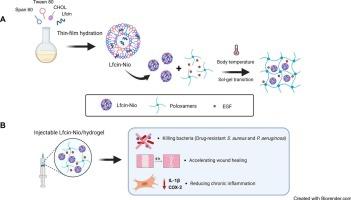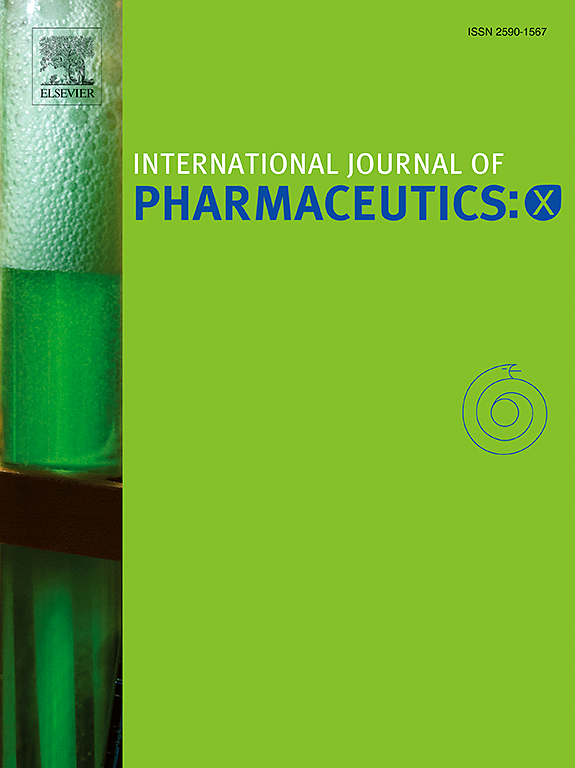Multifunctional poloxamer-based thermo-responsive hydrogel loaded with human lactoferricin niosomes: In vitro study on anti-bacterial activity, accelerate wound healing, and anti-inflammation
IF 5.2
2区 医学
Q1 PHARMACOLOGY & PHARMACY
引用次数: 0
Abstract
Chronic wound infections are attributed to delayed tissue repair, which remains a major clinical challenge in long-term health care. Particularly, infections with antibiotic resistance have more serious effects on health, often resulting in unsuccessful treatments. Thus, antimicrobial peptide (AMP)-based therapy holds promise as a potential therapeutic approach to overcoming drug resistance. Conventional wound dressing is a passive strategy for wound care that is not capable of eradicating pathogens and promoting tissue repair. In this study, we aim to construct an advanced wound dressing; a thermo-responsive hydrogel incorporated with lactoferricin (Lfcin) niosome (Lfcin-Nio/hydrogel) for bacterial pathogen treatment. The Lfcin-loaded niosome (Lfcin-Nio) has a particle size of 396.91 ± 20.96 nm, 0.38 ± 0.01 of PdI, −10.5 ± 0.3 mV of ζ potential, and 72.30 ± 7.05 % Lfcin entrapment efficiency. Lfcin-Nio exhibited broad antibacterial activity on both drug-susceptible and drug-resistant strains, and also on bacteria residing in the biofilm matrix. The Lfcin-Nio/hydrogel was fabricated from 0.5 % w/v poloxamer 188–20 % w/v poloxamer 407, and supplemented with Lfcin-Nio and epidermal growth factor (EGF). The physical properties of Lfcin-Nio/hydrogels showed elasticity, swelling ability, and strong injectability with responsiveness to 33–37 °C temperatures. The biological properties of Lfcin-Nio/hydrogels exhibited a bactericidal effect against drug-resistant strains of S. aureus and P. aeruginosa, and showed less toxicity to the human skin fibroblast. It also promoted the healing of scratches by 55 % within 6 h, compared to the wound closure rate of 20 % in the cell control. The inflammatory response of the Lfcin-Nio/hydrogel-treated cells was reduced via suppression of IL-1β and COX-2 mRNA expressions. From this study, Lfcin-Nio/hydrogels can be suggested as a modern wound dressing that possesses multifunctional and beneficial properties for the management of chronic wound infections.

以聚氧乙烯醚为基础的多功能热响应水凝胶载入人乳铁蛋白纳米体:关于抗菌活性、加速伤口愈合和抗炎的体外研究
慢性伤口感染是由于组织修复延迟造成的,这仍然是长期医疗保健的一大临床挑战。尤其是具有抗生素耐药性的感染对健康的影响更为严重,往往导致治疗失败。因此,基于抗菌肽(AMP)的疗法有望成为克服耐药性的一种潜在治疗方法。传统的伤口敷料是一种被动的伤口护理策略,无法根除病原体和促进组织修复。在本研究中,我们旨在构建一种先进的伤口敷料;一种含有乳铁蛋白(Lfcin)niosome(Lfcin-Nio/hydrogel)的热响应水凝胶,用于治疗细菌病原体。Lfcin-loaded niosome(Lfcin-Nio)的粒径为 396.91 ± 20.96 nm,PdI 为 0.38 ± 0.01,ζ电位为 -10.5 ± 0.3 mV,Lfcin 的夹持效率为 72.30 ± 7.05 %。Lfcin-Nio 对药物敏感菌株和耐药菌株以及生物膜基质中的细菌都具有广泛的抗菌活性。Lfcin-Nio/hydrogel 由 0.5 % w/v poloxamer 188-20 % w/v poloxamer 407 制成,并添加了 Lfcin-Nio 和表皮生长因子(EGF)。Lfcin-Nio/水凝胶的物理性质显示出弹性、溶胀能力和较强的注射性,对 33-37 °C 的温度反应灵敏。Lfcin-Nio/hydrogels 的生物特性表现出对金黄色葡萄球菌和绿脓杆菌耐药菌株的杀菌作用,对人体皮肤成纤维细胞的毒性较低。它还能促进划痕在 6 小时内愈合 55%,而细胞对照组的伤口闭合率仅为 20%。通过抑制 IL-1β 和 COX-2 mRNA 的表达,Lfcin-Nio/水凝胶处理细胞的炎症反应有所减轻。从这项研究中可以看出,Lfcin-Nio/水凝胶是一种现代伤口敷料,具有治疗慢性伤口感染的多功能和有益特性。
本文章由计算机程序翻译,如有差异,请以英文原文为准。
求助全文
约1分钟内获得全文
求助全文
来源期刊

International Journal of Pharmaceutics: X
Pharmacology, Toxicology and Pharmaceutics-Pharmaceutical Science
CiteScore
6.60
自引率
0.00%
发文量
32
审稿时长
24 days
期刊介绍:
International Journal of Pharmaceutics: X offers authors with high-quality research who want to publish in a gold open access journal the opportunity to make their work immediately, permanently, and freely accessible.
International Journal of Pharmaceutics: X authors will pay an article publishing charge (APC), have a choice of license options, and retain copyright. Please check the APC here. The journal is indexed in SCOPUS, PUBMED, PMC and DOAJ.
The International Journal of Pharmaceutics is the second most cited journal in the "Pharmacy & Pharmacology" category out of 358 journals, being the true home for pharmaceutical scientists concerned with the physical, chemical and biological properties of devices and delivery systems for drugs, vaccines and biologicals, including their design, manufacture and evaluation. This includes evaluation of the properties of drugs, excipients such as surfactants and polymers and novel materials. The journal has special sections on pharmaceutical nanotechnology and personalized medicines, and publishes research papers, reviews, commentaries and letters to the editor as well as special issues.
 求助内容:
求助内容: 应助结果提醒方式:
应助结果提醒方式:


